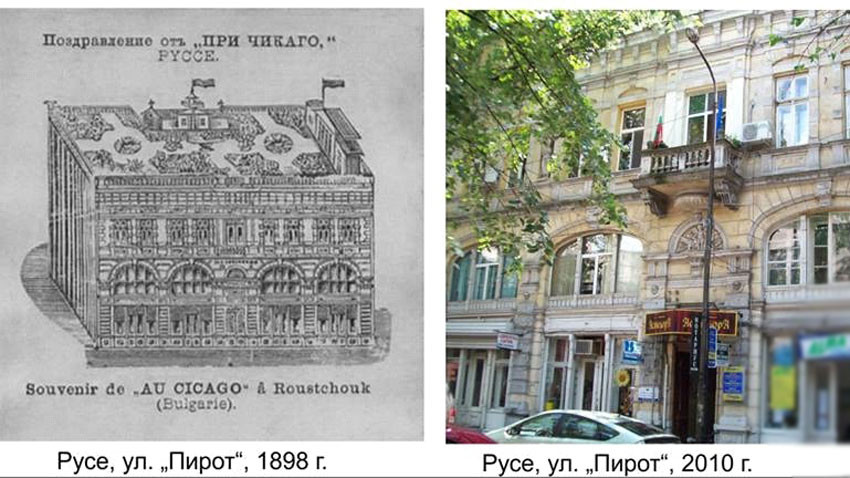Ruse is one of the Bulgarian cities with history that can be traced back to ancient times. It is situated on the banks of the Danube River and people have been living in the area for thousands of years.
Throughout the millennial history of the city, its inhabitants have been traders and intellectuals, and during the Ottoman rule and the National Revival, Ruse was home to many Bulgarian revolutionaries who participated in national liberation struggles. After the Liberation and the partition of the country by the Berlin Congress (1878) into the Principality of Bulgaria and Eastern Rumelia, Ruse became the largest city in the Principality. It underwent a rapid economic boom and this apparently changed the urban planning and the city’s look. More and more new buildings emerged, influenced by the modern European architectural styles of the time, such as Baroque and Secession. This made citizens call the city "Little Vienna". Owners of new buildings most often were bankers and merchants, whose travels and successful business in Europe and around the world allowed them to invest much money in creating architectural gems.
“One of the interesting buildings is the hotel of a man known as ‘the Chicago,’” Mariana Melnishka who is author of a two-volume story about the architectural heritage of Bulgaria says. “It was named after its owner, Solomon Blaustein, who left for America immediately after the Liberation. With the money he earned, he returned to this country and invested it into a large, lucrative building.

It is very beautiful, full of niches on the facade, decorated with figures of girls. The building was an important one for a Danubian city as it included a cabaret and hotel. Its owner hired dancers from other Danube countries as well and he created a fashion studio on the ground floor. The building includes the country's first human-powered elevator.”
We should mention two more landmarks for the city, whose value is more historic than architectural. These are the houses of Nikola Obretenov and his parents – Tonka and Tiho Obretenov. Nothing remains of the latter because of Ruse’s reconstruction in the early 20th century, but the house of Nikola Obretenov, who was descendant of one of the most famous families from the National Revival period, preserves the memory of his owner. There are numerous legends surrounding the personality and life of the last survivor who was part of the revolutionary group led by poet and revolutionary Hristo Botev. After the death of Hristo Botev and the destruction of the company, Obretenov was imprisoned in Diyarbakir, where he remained until the Liberation. Upon his return to Bulgaria, he, like many other national liberation fighters, received the opportunity to occupy a high position in the government of the new state.

“Obretenov became MP and then mayor of Ruse. It was at that time when he built his two-storey house. Its style is neoclassical and currently houses a museum. Until 1989, tourists visiting the museum were told things that were completely different than the true tragic story of this house. Nikola Obretenov had a daughter, Tonka, who met Bulgarian intellectual Niko Prosenichkov who studied philosophy in Germany. Upon his return to Bulgaria, he devoted himself to education and became director of the Men's High School in Ruse – one of the most prestigious high schools back then after those in Gabrovo and Svishtov.”
Shortly after the communist coup in Bulgaria on September 9, 1944, Prosenichkov was killed, along with countless enlighteners and many of Bulgaria’s intelligentsia. His wife, who refused to leave him, was shot and killed too. The family had two daughters. One of them Milkana, died of grief and the other, Liliana, was sent to a concentration camp, where she managed to survive despite the brutalities she was subjected to. Meanwhile, strangers were accommodated into the family house by the communist regime they burned the family library and destroyed valuable documents revealing details of Bulgaria’s past. After finally Liliana received her freedom, she met artist Nenko Balkanski while he was in Ruse to paint a portrait of her grandmother. After hearing her horror story and being captivated by her beauty, he married her and she became his muse and model.
English: Alexander Markov
Photos: ilovebulgaria.eu and archiveTrapezitsa is one of the three hills for which the old Bulgarian capital, Tarnovgrad (the medieval name of today’s Veliko Tarnovo), is famous . Located to the northwest of the town, it stands across from the neighboring hill Tsarevets – the..
On the feast of the Dormition of Saint Ivan Rilski, the Bulgarian Patriarch and Metropolitan of Sofia Daniil led the Divine Liturgy at the Rila Monastery. On the eve of the feast, he bowed before the relics of the patron saint of the Bulgarian people..
Today, August 18, the Bulgarian Orthodox Church marks the Dormition of St. John of Rila – the heavenly patron of Bulgaria. He is the most beloved saint in Bulgaria and is revered even beyond the borders of this country. We associate..
On November 21, the day of the Presentation of Virgin Mary (or the Entry of the most Holy Theotokos into the Temple), the Orthodox Bulgarians also celebrate..

+359 2 9336 661
